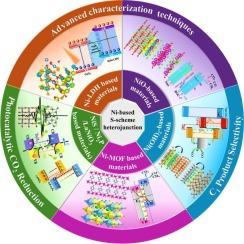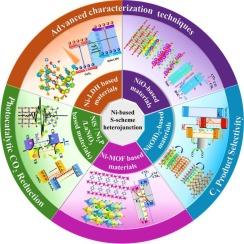镍基s型异质结的策略设计和机理揭示:配位化学,光谱证据和未来方向
IF 23.5
1区 化学
Q1 CHEMISTRY, INORGANIC & NUCLEAR
引用次数: 0
摘要
应对不断上升的人为二氧化碳水平与联合国可持续发展目标(SDG)直接相关,特别是可持续发展目标7(负担得起的清洁能源)和可持续发展目标13(气候行动)。CO2光还原成C1产物,即CO和CH4,为减少温室气体排放提供了有利途径。在各种修饰策略中,s -图式异质结结构以其提高载流子分离效率、减少载流子重组、强氧化还原能力、增强光催化性能等优点,在材料化学领域中有着耀眼的光芒。本文重点探讨了镍基S-scheme结用于CO2还原的最新进展,重点介绍了其界面电荷转移动力学,以实现高选择性。首先,介绍了CO2光还原的一般机理,提供了必要的背景知识。然后探讨了基于Ni- ldh、NiO、Ni(OH)2、Ni- mof、NiS、Ni2P等与合适的半导体集成的S-scheme异质结的发展机理和各种类型的S-scheme异质结。镍基光催化剂具有很强的稳定性、合适的能带电位、成本效益和稀土丰富的性质,是s型异质结的潜在组成部分。利用DFT、KPFM和ISI-XPS等先进的光谱技术验证了S-scheme电荷转移路线。此外,还讨论了CO2还原途径,重点讨论了CO2吸附、活化、中间稳定性和C1产物选择性。最后,本文概述了该领域各自的挑战和未来前景,希望这项工作为开发光催化二氧化碳还原技术提供战略见解,支持追求全球碳中和目标。本文章由计算机程序翻译,如有差异,请以英文原文为准。


Strategic design and mechanistic unveiling of Ni-based S-scheme heterojunctions for efficient CO2 photoreduction to C1 products: Coordination chemistry, spectroscopic evidence, and future directions
Tackling the rising anthropogenic CO2 level aligns directly with the United Nations Sustainable Development Goals (SDGs), exclusively SDG 7 (Affordable and Clean Energy) and SDG 13 (Climate Action). The CO2 photoreduction into C1 products, i.e., CO and CH4, provides a favorable route to reduce greenhouse gas emissions. Among various modification strategies, the S-scheme heterojunction construction has a bright shine in the material chemistry field owing to its enhanced charge carrier separation efficiency, minimized charge carrier recombination, strong redox ability, and enhanced photocatalytic performance. The review significantly explores the recent advancements in Ni-based S-scheme junctions for CO2 reduction, highlighting their interfacial charge transfer kinetics to achieve high selectivity. Firstly, the general CO2 photoreduction mechanism was introduced to provide essential background knowledge. The article then probes the development of S-scheme mechanism and various classifications of S-scheme heterojunctions based on Ni-LDH, NiO, Ni(OH)2, Ni-MOF, NiS, Ni2P, etc., integrated with suitable semiconductors. Ni-based photocatalysts are a potential component within S-scheme heterojunctions because of their strong stability, suitable band potentials, cost-effectiveness, and earth-abundant nature. The advanced spectroscopic techniques, including DFT, KPFM, and ISI-XPS, are highlighted to validate the S-scheme charge transfer route. Moreover, the CO2 reduction pathways were discussed with the primary focus on CO2 adsorption, activation, intermediate stability, and C1 product selectivity. Finally, the article outlines the respective challenges and future prospects in the field with the hope that this work offers strategic insight for developing photocatalytic CO2 reduction technologies, supporting the pursuit of global carbon neutrality goals.
求助全文
通过发布文献求助,成功后即可免费获取论文全文。
去求助
来源期刊

Coordination Chemistry Reviews
化学-无机化学与核化学
CiteScore
34.30
自引率
5.30%
发文量
457
审稿时长
54 days
期刊介绍:
Coordination Chemistry Reviews offers rapid publication of review articles on current and significant topics in coordination chemistry, encompassing organometallic, supramolecular, theoretical, and bioinorganic chemistry. It also covers catalysis, materials chemistry, and metal-organic frameworks from a coordination chemistry perspective. Reviews summarize recent developments or discuss specific techniques, welcoming contributions from both established and emerging researchers.
The journal releases special issues on timely subjects, including those featuring contributions from specific regions or conferences. Occasional full-length book articles are also featured. Additionally, special volumes cover annual reviews of main group chemistry, transition metal group chemistry, and organometallic chemistry. These comprehensive reviews are vital resources for those engaged in coordination chemistry, further establishing Coordination Chemistry Reviews as a hub for insightful surveys in inorganic and physical inorganic chemistry.
 求助内容:
求助内容: 应助结果提醒方式:
应助结果提醒方式:


